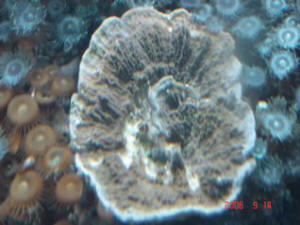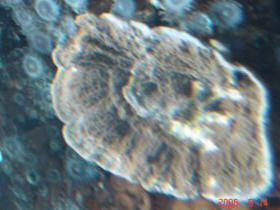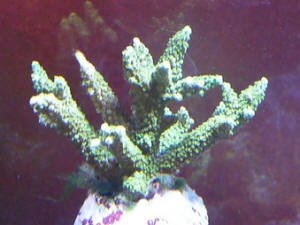|
FAQs about Acroporid Coral Disease/Health,
Parasites, Pests 3
FAQs on Acroporid Disease:
Acroporid Disease 1, Acroporid Disease 2,
Acroporid Disease/Pests/Predators
4, Acroporid Health
5, Acroporid Health
6, Acroporid Health
7, Acroporid Hlth.
8, Acroporid
Hlth. 9, Acroporid Hlth. 10,
FAQs on Acroporid Disease by Category:
Diagnosing,
Environmental (Pollution/Poisoning, Lighting...),
Nutritional, Social (Allelopathy),
Trauma,
Pathogenic (Infectious, Parasitic, Viral)
Predatory/Pest
(see below), Treatments
FAQs on Pests of Acroporids:
Montipora Munching Nudibranchs,
Flatworms,
Red/Black "Bugs"
Acropora Munching Copepods,
Related Articles: Coral Pests and Disease; pests, predators,
diseases and conditions by Sara Mavinkurve, Acroporids, SPS
Corals,
FAQs on Stony Coral Disease by Type: Brown Jelly Disease, RTN,
|

|
| Coral Bleaching 1/12/06 Hello and
hope everything is starting out well for you and the crew this
year. <And for you> I have a hundred gallon reef
tank. 50x19x24. I'm using a Nova Extreme
with 4-56 watt T5 actinics and 4-56 watt T5 10K white on a 12-hour
for the blue and 10-hour for the white schedule. I have
a wonderful red Montipora capricornis that I've had for 2
months now on the top shelf of the aquarium and it has done great,
kept it's color and has grown. I also have a small
Acropora sp. that I've had for about a month. It
also has done ok. Feeling like I could handle anything I
went out and bought a beautiful yellow Acropora, picture attached,
and put it on the top shelf also. Everything was going
great until the other day. I got up in the morning and
quit a bit of the bottom of the coral had bleached. <I see
this> Could this be lack of sufficient light or do I have
something else going on here? Thanks again. <Mmm,
due to the location of the bleaching, the fact that your other
stony corals (Acroporids all) are doing fine, I do think your
hypothesis re lighting being deficient here may be valid... You do
feed your systems cnidarians? All checks out biomineral and
alkalinity wise? If so, then this Staghorn should regenerate its
lost tissue. Please read here: http://www.wetwebmedia.com/acrodisfaqs.htm and the linked
files above. Bob Fenner> |
|

|
SPS bleaching 5/8/06 Hi Bob,
<Mohamed> I have read the information on http://www.wetwebmedia.com/acropori.htm a number of times. I
have noticed today that some of the sps have cream patches. I have no
idea what that is. <Mmm... can be nothing... happens in the wild
even...> The biggest problem with SPS is water quality to my
understanding and I do 50L water change a week on a 600L system. If I
understand, if I improve my water quality much more, I should not have
a problem. Thanks Mohamed. <Water quality is
number one... nutrition a factor also. Bob Fenner>
"Bubble" on My Acropora - 10/20/06 Hi.
<<Hello>> I have a very quick question I hope you can help
me with. <<I shall try>> I have an Acropora coral that has
a bubble type appendage toward it's base where it appears it was
snapped off from the mother colony. The bubble is not brown
(dreaded jelly disease) and looks healthy with extended small polyps
extending off the bubble. I have had the coral for at least
5-6 months now. The coral is growing well and other then the
bubble in question is in perfect health with very good color and polyp
extension mostly at night with a little during the day. I
have no idea what this bubble is and I can't find anything on
it. All my other Acros are doing great. If I am
naive and this is the start of some kind of infection I want to get on
it before it gets out of hand. <<I doubt this is an
"infection," these usually act quite fast and you would heave
noticed some deleterious effect by now. I suspect what you
have is a "parasite"...despite how that sounds, in this
instance these are usually symbiotic or at least commensal
relationships and thus benign. Some crustaceans are known to
take up residence on the skeleton/in the flesh of Acropora
corals. The most common that I have witnessed are small
barnacle looking crustaceans and very small crabs...the latter is
visibly active (feeding) from a small opening in the corals flesh, the
latter is usually completely encased in a lump or goiter of the corals
flesh. To my knowledge and in my experience, neither do
permanent harm or prevent the coral from growing/flourishing>> For the record my water parameters are: 0 nitrate 0 Ammonia
0 Nitrite 0 Phosphate Alk 11 (stable) Calcium 380 SG 1.025, Temp 80 PH
8.3 (stable with reverse light cycle on refugium) The coral has a nice,
healthy strong random flow over it. No linear current or
anything. The coral is housed under (2) 150watt HQI metal
halide and 260watts of mixed PC 10k and actinic and is in the top 1/4
of the tank. I have attached a picture however it is not
very good quality. The best I can do with my meager
equipment. <<I'm afraid we didn't get the picture>>
I was hoping you could provide some insight on the matter. <<I
don't think you need be concerned. Any
"treatment" of the coral is likely to do more harm than
good>> Thank you very much you are always a great help. Regards,
John Weglarz <<Happy to assist. Eric
Russell>>
"Bubble" on My Acropora - II - 10/21/06 Hello
again. <<Hello John>> Thank you for the reply Eric.
<<My pleasure>> I believe your diagnosis is dead accurate.
<<I do get lucky sometimes <grin> >> I have not seen
any parasites/crabs though they may be to small for me to see with the
naked eye, or perhaps I am not looking close enough or at the right
time. For the record when the goiter does burst there is
perfectly healthy flesh underneath and it seems this phenomena started
when the Acropora began growing rapidly. <<Hmm, curious...but if
the coral does not seem to be suffering any deleterious effects from
this I would leave it be>> As you stated and I have witnessed
there is no harm done, it just struck me as being odd and I was
concerned it may be the start of something detrimental.
<<Understood>> I did a lot of research on the matter and I
couldn't find any information on this topic. I believe
your explanation on this matter will be instrumental in putting other
reef keepers concerns at ease should they encounter this phenomenon.
<<Or at least encourage them to research/observe before taking a
hasty course of action that can often be more harm than good>>
Thank you ever so much. Regards John Weglarz <<Always happy to
help, Eric Russell>>
Acropora color loss 10/7/06 Hello, <Hi there> Let
me start this question by giving you the current condition of my setup.
I have a 26 gallon bow front tank. I have 20lbs of live sand, 30 lbs of
live rock. I'm running a Prizm HOT skimmer and fluvial <Heee,
Fluval, but flowing> canister filter. My lighting is the Coralife Aquapro, 1 x 150w 10K MH and 2 x 65w actinic and lunar lights. The
photo period is 12 hours on, 12 hours off. The lights are suspended
8" above the surface of the water. I am running 2
small Rio pumps for additional circulation. I have a 6 gallon refugium
attached to all of this as well. <Sounds nice> I have only 1
tomato clown in this system, 1 sand sifting star, 2 emerald green
crabs, a dozen blue leg hermits and a tuxedo urchin. The refugium has
grape Caulerpa, Chaetomorpha, and Halimeda with the 20w 50/50 lights
running 24/7. My water condition is as follows: Ammonia, Nitrites,
Nitrates all zero(0). Phosphates < .10 (so small it's difficult
to measure). Specific gravity as measured by a swing arm 1.023. Calcium
420. PH is around 8.0 - 8.3 depending on the time of day. Temp is 75
degrees F. The water is crystal clear. I dose with Aragamilk, purple
up, Kent essential elements as directed on the bottles. <Would add
in the new water during changes only> I change 5 gallons out 1 per
month and top off with RO/DI water. I have a CoraLife SpectraPure RO/DI
unit. I feed with Cyclop-eeze once daily. I decided I wanted to try my
hand at a few Acropora. <... not easy in small systems> I bought
a green Acropora and have noticed some encrusting and growth. So I
bought a beautiful powder blue Acropora (base ball sized colony). After
3 weeks, the Acropora has lost it's powder blue color in favor of a
tan and emerald green color. <Oooh> I thought, perhaps that it
was due to flow and lighting, so I moved it to a place higher in the
talk with more flow. <Worth trying> Still it is losing more of
the light blue color. The distance from the light system to this
Acropora is about 15 inches. <Mmm, likely still "way too
far"... needs much more intense light, to be in just a few inches
of water here> Aside from the color change, the Acropora looks
healthy. Polyps extend at night and there is no sign of necrosis or
tissue damage of any kind. One additional piece of information: when I
bought this coral, my LFS had only had it for a week or so. <Could
be a factor...> I have only been at this hobby since 2003. Finally
the question: what could be the cause of my Acropora losing it's
color? <Mmm, likely as you state... circulation and light intensity
(rather than quality)... and possibly water quality... Please read
here: http://www.wetwebmedia.com/acrosysfaqs.htm and the linked
files above. Bob Fenner> Thanks for your help in advance. Best
Regards,
Terry
| Spots on My Plating Montipora - 09/15/06 Hi
Bob, <<EricR here with you this morning>> While waiting
for the Alf Nielsen books I need some help please... <<Good
books...let's see if I can help>> Attached you will find
two pictures of my Montipora, <<I see them>> A small
story, I bought it in July and it was green, late in August, it
changed to brown and now some small green spot can be seen on its
surface. <<Environmental issues...likely related to lighting,
but could also be water quality...and not necessarily because
either are "bad", but only that they are
"different" from whence it came>> My concern is in
the light brown patches, in the center, there was some sort of
deposit on it and after I used a "turkey blaster" to blow
away the sediments I discovered those spots. <<See this all
the time with "plating" type corals...very
common. The "spots" are a result of the
sediments/sand/whatever blocking light and smothering the tissue
underneath. Removal of the sediment usually results in
new growth/complete recovery of the afflicted area. Many
aquarists use the turkey baster approach as part of their weekly
maintenance regimen. Increasing water flow in the
vicinity of the coral may also help with keeping sediments from
settling on the coral>> What is the recommended course of
action?? <<Just as you have done...the coral will do the
rest>> Lugol's dip?? <<Nope>> Thanks for your
help Claudio Dioguardi <<I'm pleased to
assist. Regards, Eric Russell>> |
|
 
|
Please help me! what are the symptoms of high trates on
Acro's? 9/4/06 Dear Mr. Fenner,
<"Ralph"> after going nearly insane for months, it
"appears" that I have found my problem with my Acro tips
receding, bleaching, or sloughing, & then, eventually dying. The
test kit that I was using over the past year was
showing 0 trates for the last 9 months. (It was showing nitrates in the 5-20 range the first
3 month, however). I tested trates about 3 weeks ago with Salifert, and
it showed 25!!!!!! So for the past 6 months, I can only guess that my
trates were between 25-80!!!!!! trates are down to 5 right now, & I
expect them to be 0 soon as I am using AZ-NO3. other param.s are as
follows: temp: 80 Salt: 1.26 <Missing a zero here> phosphates:
.008 Calcium: 440 Alk: 9.0 / 3.2 Mag:1500 2 questions: 1) would sky
high trates cause the tips to do that? <Mmm, could... or perhaps
better put, whatever the cause of this high nitrate reading might well
be involved> 2) if you have used AZ-NO3 before, what do you think?
Also, were all fish, Acro's, inverts ok? <Maybe... is a good
product... generally "works"> Thanks A lot for your
feedback! Ralph Scheriff Hobby Experience: 08-23-2005 Current Tanks: 55
gallon Reef, AGA mega-flow II sump, ASM G-2 Skimmer, 2 x 150 HQI &
LED, fuge, 65 #LR, reactor w/ ROWA, Tunze 6060, Seio 820, Seio 620,
Various SPS, 1 Pagoda, 2 Clowns, 3 Chromis, Gamma, Talbot, & YWG.
<You should see some improvement in your SPS within a few weeks if
the high nitrate was a direct cause. Bob Fenner>
| To Bob Fenner please (micro-organism
ID) 8/27/06 Hi Mr. Fenner, <Dom> Hope
you're well. I recently got a new Montipora capricornis and it
seems to do doing very fine overall. I already see some growth and
the already nice colors are improving. But, in a specific area it
started to bleach slowly. It's still progressing and I saw some
1-2mm pure white threads on the bleached areas. I cant see them
moving. I took a sample and made a picture under microscope (please
see attached file, magnification 40X). It doesn't move much
under the microscope, only what I presume to be the head (top right
corner on the picture) was doing a slow searching motion from side
to side. Obviously its a worm and it looks a bit like a lamprey
(the mouth for example) and it looks like it has a bunch of eggs
attached on two points along the body. Can you ID it and can you
give an advice on how to deal with it? Can it parasite a fish as
well? <Highly unlikely> Many thanks! Dominique <Mmm, might
be a trematode... maybe an "intermediate" form of a
Polychaete species. Predaceous, not parasitic if so. There are
quite a few possibilities:
http://64.233.161.104/search?q=cache:9XOLiCgqBC4J:www.advancedaquarist.com/issues/apr2002/appendix.
htm+worm+predators,+parasites+of+montipora&hl=en&gl=us&ct=clnk&cd=5
Based on its apparent morphology... The "basic" or S.O.P.
for removal and prevention of such predators is best outlined here:
http://www.liveaquaria.com/general/general.cfm?general_pagesid=351
Bob Fenner> |
| Re: To Bob Fenner please (micro-organism ID)
8/27/06 Hi Mr. Fenner, I did a Lugol's dip and
discovered the real culprits: Nudibranchs (the worm I sampled
probably has nothing to do with my problems after all,
coincidental...(?)). They look exactly the same as those on the
link you sent me. <Ah, yes... what you had thought were
"eggs" were actually "naked gills"> I did a
search on the net and found quite a few info but not very
encouraging. In a forum Eric Borneman said there is no solution at
all to that problem and that even Levamisole or Tetra Oomed
doesn't really work. Some say they do work so I was willing to
try anyway but they are both impossible to find. If you have a
different opinion or hints please let me know. Thanks again !
Dominique <Physical removal and the search for a designated
predator... Bob Fenner> |
|

|
Please help! It looks like my Acro tips are
dying! 7/16/06 I cannot find any info anywhere
about coral tips, no books, web, email, nothing! <Mmm...>
Please help! It appears the tips are dying, and are not growth. The
polyps are receding from the tips. The Acro has been in tank for 3
weeks. Over the past month, Phosphate had been at levels from a
high of .25 to a low of .10! <This is likely not a
problem...> (Hair algae bloom going on, but should go away since
phosphate level has finally been controlled! Today they are at zero
using Salifert and LaMotte (Merck test is on the way) All other
water perimeters are good. If it's from phosphate, will they
recover? Can they recover? <Can, may likely do so... Three weeks
is a very short time for adjustment with stony corals of this
sort...> Ammonia=0 trates & trites=0 Calcium=390 Alk= 3.89 /
10.9 PH= 8.2 Salt=1.26 temp=80 I don't believe the tips are
growth (but they could?), <Yes... is what this appears to me to
be> because the polyps have receded from the tip area, and also,
3 of the tips look grayish with a little brown algae on it (it
looks like a smokers tooth) and 1 tip had some small brown matter
swinging off the end of it. The lights are 10 inches from the tips.
Would phosphate cause that? <Could, yes> Phosphate right now
is undetectable with Salifert. However, it was fairly high over the
past month. It slowly lowered until it became undetectable last
night & today. Sincerely, Ralph Scheriff 55 gallon Reef, AGA
mega-flow II sump, ASM G-2 Skimmer, 2 x 150 HQI & LED, fuge, 65
#LR, SPS, 1 Pagoda, 1 Klyxum, 2 Clowns, 7 Chromis, Gamma, Talbot,
Goby, & ywg. <I would not panic, or move this colony... All
will likely be fine here in another week or two. You have read
here: http://www.wetwebmedia.com/acropori.htm and the linked
files above?
Bob Fenner> |
|
 
|
|
Before tips died (page 2)
7/16/06 This one looks like the start of a Staghorn across.
give it good, random water flow and you should get more
symmetrical growth out of that crown. Sincerely, Eugene Y. Marine
Depot Live Customer Service www.marinedepotlive.com
<I agree with Eugene. BobF>
|
|

|
|
|

